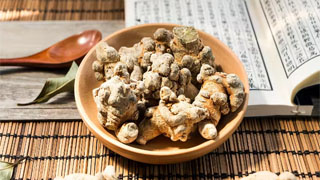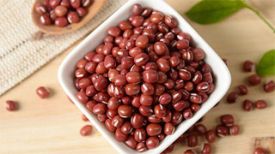
1. Aliases
Tianqi, Sanqi, Panlongqi, Jinbuhuan, Blood Ginseng, and Shanqi.
2. Plant morphology
Perennial herbs. The rhizome is short and oblique; The main root is robust, fleshy, inverted conical or cylindrical, often with warty branching protrusions. The stem is upright and not branching. Palm shaped compound leaves, 3-4 whorled at the top of the stem, small leaves usually 5-7, membranous, long elliptical obovate or oblong lanceolate, with 1 pair of smaller base, apex gradually pointed, base nearly circular, mostly asymmetric, leaf edges with fine serrations, and teeth with small bristles.
Umbelliform inflorescences are solitary and terminal, with small flowers, mostly bisexual, and few heterozygous. Calyx 5-toothed; Petals 5, yellow green, apex pointed; 5 stamens, linear filaments; The upper part of the style separates into 2. Drupe berry shaped, nearly renal shaped, red when mature. The flowering period is from June to August, and the fruiting period is from August to October.
3. Origin distribution
Wild in the jungle on mountain slopes. Currently, it is mostly cultivated on slopes at the foot of mountains or gentle slopes of soil mounds at an altitude of 800-1000 meters. It is recommended to use acidic soil with loose soil and rich humus. Distributed in Guangxi, Sichuan, Yunnan and other places.
4. Harvesting and processing
Generally, it takes 4 years to harvest, and those who harvest before the autumn flowers bloom are called "Spring Seven", full and of good quality; After the seeds mature in November, those who collect and excavate them are called "Winter Seven", which is relatively loose and of poor quality. After excavation, remove the aboveground stems and sediment, cut off the reed head, lateral roots, and fibrous roots, wash them, and dry them in the sun.
5. Characteristics of medicinal herbs
Class conical or cylindrical. The surface is grayish brown or grayish yellow, with intermittent longitudinal wrinkles and branching marks. There are stem marks at the top and nodular protrusions around it. Weight, solid texture, often separated from the wood after breaking, with gray green, yellow green, or gray white cross-sections. The skin has small brown spots, and the wood has a slightly radial texture. Qi is subtle, taste bitter and then slightly sweet.
6. Nature, taste, and meridian tropism
Warm in nature, sweet and slightly bitter in taste. Guigan Meridian and Stomach Meridian.
7. Effect and function
Dispel blood stasis, stop bleeding, reduce swelling and relieve pain. A blood stasis and hemostatic medication that belongs to the subcategory of hemostatic drugs.
8. Clinical applications
Dosage 5-10 grams, decoct soup for consumption; Apply external grinding juice, grind and sprinkle, or adjust to apply to the affected area. Used to treat hemoptysis, vomiting, epistaxis, rectal bleeding, metrorrhagia, traumatic bleeding, chest and abdominal pain, and swelling and pain.
9. Pharmacological research
Animal experiments have shown that ginsenosides Rg have an excitatory effect on the central nervous system, while Rb have an inhibitory effect. Total saponins of Panax notoginseng can inhibit platelet aggregation, and Panax notoginseng extract has cardiotonic, antihypertensive, hepatoprotective, anti-inflammatory, cholesterol lowering, immune regulatory, and antiviral effects.
In general, it has hemostatic, antiplatelet aggregation, thrombolytic, hemolytic, and hematopoietic effects on the blood and hematopoietic system; It has anti arrhythmias, anti atherosclerosis, anti hypoxia and anti shock effects on cardiovascular system, and can improve cerebral ischemia; Has central nervous system inhibitory and analgesic effects on the nervous system; Can enhance immune function, protect liver function, anti-tumor, delay aging, lower blood sugar, anti-inflammatory, regulate substance metabolism, and promote growth; Low toxicity, long-term medication with minimal side effects.
10. Chemical composition
It mainly contains 12 monomeric saponins, including ginsenoside Rg ₁, quercetin, acetic acid, syringene, ginsenoside Re, leucine, β - sitosterol D-glucoside, ginsenoside, and Panax notoginseng saponin, as well as the hemostatic ingredient Tianqi amino acid. It also contains volatile oil and various trace elements.
11. Taboos for use
Pregnant women should use with caution.
12. Compatibility prescription
① Treatment of internal injuries caused by falls: Mix 15 grams of Sanqi powder with live crabs and mash them together. Drink warm wine and drink. (Guangxi Ethnic Medicine Compendium)
② Treatment of chronic prostatitis: 3g of Sanqi powder, once every other day, with plain water administered. [Henan Traditional Chinese Medicine 1985, (3): 27]
③ Treatment of blood deficiency and dizziness: 3g of Panax notoginseng, finely ground powder; A pigeon, remove the internal organs, fill the stomach with medicinal powder, and steam it to eat. (Chinese Herbal Medicine Handbook of Qujing Special Zone)
④ Treating Qi and blood weakness: 3g of Panax notoginseng and 6g of ginseng. Grind finely and eat steamed meat cakes. (Chinese Herbal Medicine Handbook of Qujing Special Zone)
⑤ Treatment of dysmenorrhea: 2-3 grams of Panax notoginseng, taken with warm water before or during menstrual pain. [Shanghai Journal of Traditional Chinese Medicine 1984, (3): 21]
The content of the article is for clinical reference only. Non professionals in traditional Chinese medicine are not allowed to try medication.


